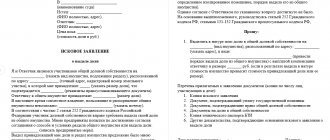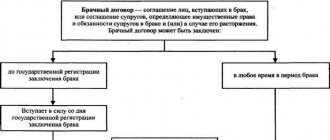When creating a company, participants rarely think about the fact that a moment may come when disagreements in the business become insurmountable and one of the owners wants to come out and get the value of his share. In this situation, the accountant is often given an impossible task: the owners who remain in the business demand to “conjure up something” in order to pay as little as possible. And the seller of the share, on the contrary, demands redemption at the real market value, not fully understanding what it is. As a rule, the accountant remains in the ranks of the company and, accepting the rules of the game, begins creative work to minimize the costs of “farewell” to the owner.
The testator's share in the property
As a rule, certain pieces of property are inherited: an apartment, a summer house, a car, etc. In most cases, the testator's share is not 100% because the property is joint. For example, the father owned a dacha together with his mother in equal shares, respectively, his share in the ownership of the dacha is 50% or ½ part. By the way, shares in property are most often expressed in simple fractions: 2/3, ¼, etc.
Share size
Indicate the size of the testator's share in the property. If the share is 100%, then indicate 1/1
Calculator for calculating the shares of LLC participants (beta)
You can distribute the balance by adding the required number of participants using the green “Add” button opposite the “Participant 1” field
Please note that the distribution occurs automatically, and therefore the remainder is divided into equal parts among the participants you added. If you want to change the monetary or percentage designation of a share for someone, then without clearing the form, simply enter the data in the required field
In this case, the size of the authorized capital will not change, but the share and balance will be recalculated. In the event that you need to find out the size of the authorized capital based on the percentage (fractional) ratios of shares or their cash equivalents that you have changed, clear the “Authorized capital” field using a gray cross and click on the “Determine the authorized capital” button again. At the same time, you will see the new capital balance and its percentage. You can also not use the balance obtained when calculating the size of the authorized capital, but immediately enter the data of all participants, and then find out how its share will change if it increases or decreases. In this case, the program will always tell you whether the size of the authorized capital has been exceeded or, conversely, whether a balance has appeared during the distribution of shares. If you want to increase the shares of participants in monetary terms, then the calculator will calculate what the size of the authorized capital should be in this case.
How are shares in an apartment calculated?
According to the norms of current legislation, at the initiative of any of the co-owners of a residential premises, the procedure for allocating a new part or redistributing existing parts can begin.
There are two possible scenarios:
- residents reach an agreement through negotiations and begin the procedure;
- Some of the owners are against it and the alienation is carried out in court.
Do not confuse the concepts of section and allotment. To make it easier to understand the differences between them, check out the table below:
| Procedure | Peculiarities |
| Chapter | Housing in shared ownership is divided into several parts, each of which becomes the private property of a specific tenant |
| Allocation | After separating a small part of it from the common property, the rest of the territory retains its previous status |
When allocating, remember that all owners have equal rights to shared living space. This means that according to the law, it should be distributed equally between them. True, family members, by mutual agreement, can distribute square meters at their own discretion.
Agreement on determining shares
The agreement of the parties is the legal basis for allocating a certain share in a shared apartment; it must reflect:
- Date of.
- Information about all parties to the agreement: full name, civil passport details, place of permanent registration.
- Subject of the agreement: how, and in what shares, the common property will be distributed.
- Description of the apartment, its cadastral characteristics.
- The final allocation of specific shares: as a percentage of the entire area of the apartment, one side has so many percentages, the other has so many percentages, and so on for all owners.
- A clause that the shares can be redefined by a separate agreement with the consent of the parties.
- Determination of improvements carried out by the parties both in the entire apartment and in the share: they can be the common property of the parties or a specific owner.
- The owner of the share, at whose expense significant improvements to the apartment were carried out, has the right to count on an increase in the right to common shared ownership.
- If income is received from commercial activities, they can be distributed in accordance with the shares of each owner.
- Limitations on the right of disposal: the second party can dispose of its share only if agreement is reached.
- Determination of the right of first refusal to acquire a share.
- Conditions for terminating the agreement, allocation of a share in kind to each party or compensation in accordance with the shares.
Expert opinionRoman EfremovExperience 5 years.
Specialization: all areas of jurisprudence. The agreement represents a peaceful option for resolving potential conflicts. The legislator gives users the right to deviate from the principle of equality when drawing up an agreement on the allocation of shares. This means that owners of square meters have the right to independently set arbitrary fractions depending on their needs.
Signatures of the parties to the agreement with transcript. Please note that in order to become the owner of a share under an agreement, it must be registered in the register of individuals, and only from the moment of registration it comes into legal force. If an agreement on determining the shares has not been signed, then they are considered equal.
Expert opinionRoman EfremovExperience 5 years. Specialization: all areas of jurisprudence.
If for some reason the users were unable to reach a consensus on concluding an agreement, the subsequent division and allocation of shares from the common real estate is possible only through the courts. It must be remembered that the requirement to allocate separate units of living space is made taking into account certain features.
In kind, allocating a share is practically impossible, since the size of the separate units does not coincide with the boundaries of the premises in the apartment. Consequently, in this situation, compensation for the cost of the share will be established. The same approach is demonstrated when solving problems associated with the impossibility of identifying independent accounting units in physical terms.
Legal mathematics, shares, fractions, proportions.
Imagine that in the above example, one of the shares is the subject of a crime and it is necessary, in relation to the value of the inherited property, to determine whether the damage is large or especially large?
And it’s somehow embarrassing for a lawyer, when a client comes to him, to demonstrate a complete inability to calculate fractions.
Fractions are needed everywhere and always, whether we count percentages, calculate the weight of goods, determine taxes, or divide property.
In many, many questions you cannot do without fractions.
Apartment share tax
You can determine the amount of property tax on the share allocated in kind by knowing the following indicators:
- footage of an immovable residential property;
- the current basic tax rate;
- cadastral or inventory price of the object.
Calculation example. Let's assume the following basic tax rate applies in your region:
- housing cost up to 300 tr. – 0.1% of the cadastral price;
- from 301 to 500 tr. – 0.2% of the cadastral price;
- 501 t.r. and above – 0.5% of the price.
The cost of all housing is 800 rubles. You own 1/3 of the area.
Let's start with the calculations:
- 800,000/3 = 267,000 (rubles) – the cost of your share;
- 267,000*0.5% = 1,335 (rubles) – the amount of property tax.
If the apartment is communal
A special procedure for using a communal apartment is housing with isolated rooms and a common space. Non-residential premises in the form of a kitchen, corridor and bathroom are used by all residents, and specific rooms are used in strict accordance with the allocated share in common law (Article 42 of the Housing Code of the Russian Federation).
The family owns one, two, three or more rooms. Owners can dispose of such living space without regard to the opinions of other residents of the communal apartment.
The calculation of the share is related to the determination of square meters of isolated premises + part of the common property of the apartment (non-residential premises).
We count the share of the total
First, let's look at a fairly common situation when we need to determine the share of one number (as a percentage) in another.
Below is the mathematical formula to accomplish this task: Proportion (%) = Number 1/Number 2*100% , where:
- The number 1 is, in fact, our initial numerical value
- The number 2 is the final number, the proportion of which we want to find out
For example, let's try to calculate what the proportion of the number 15 is in the number 37. We need the result as a percentage. In this case, the value of “Number 1” is 15, and “Number 2” is 37.
- Select the cell where we need to make calculations. We write the equal sign (“=”) and then the calculation formula with our numbers: =15/37*100%.
- After we have typed the formula, we press the Enter key on the keyboard and the result will immediately appear in the selected cell.
For some users, the resulting cell may display a simple number instead of a percentage value, sometimes with a large number of digits after the decimal point.
The thing is that the cell format for displaying the result is not configured. Let's fix this:
- Right-click on the cell with the result (it doesn’t matter whether it was before we wrote the formula in it and got the result or after), in the list of commands that appears, click on the “Format Cells...” item.
- In the formatting window we will find ourselves in the “Number” tab. Here, in number formats, click on the line “Percentage” and in the right part of the window indicate the desired number of decimal places. The most common option is “2”, which is what we use in our example. After that, click the OK button.
- Done, now we will get exactly the percentage value in the cell, which is what was originally required.
By the way, when the display format in a cell is configured as a percentage, it is not at all necessary to write “ *100% ” in the formula. It will be enough to perform a simple division of numbers: =15/37.
Let's try to apply the acquired knowledge in practice. Let's say we have a table with sales for various items, and we need to calculate the share of each product in total revenue. For convenience, it is better to display the data in a separate column. Also, we must calculate in advance the total revenue for all items, into which we will divide sales for each product.
So, let's get started with the task:
- Select the first cell of the column (not counting the table header). As usual, writing any formula begins with the sign “ =“. Next, we write a formula for calculating the percentage, similar to the example discussed above, only replacing specific numerical values with cell addresses that can be entered manually, or adding them to the formula with mouse clicks. In our case, in the cell E2 you need to write the following expression: =D2/D16.
Note: do not forget to configure the format of the cells of the resulting column in advance by selecting display as percentages. - Press Enter to get the result in the specified cell.
- Now we need to make similar calculations for the remaining rows of the column. Fortunately, Excel allows you to avoid manually entering a formula for each cell, and this process can be automated by copying (stretching) the formula to other cells. However, there is a small nuance here. In the program, by default, when copying formulas, cell addresses are adjusted according to the offset. When it comes to sales of each individual item, this is how it should be, but the coordinates of the cell with the total revenue should remain unchanged. To fix it (make it absolute), you need to add the symbol “ before the row and column designations. $“. Or, to avoid typing this sign manually, by highlighting the cell address in the formula, you can simply press the key F4. When finished, press Enter.
- Now all that remains is to stretch the formula to other cells. To do this, move the cursor to the lower right corner of the cell with the result, the pointer should change its shape to a cross, after which we stretch the formula downward by holding down the left mouse button.
- That's all. As we wanted, the cells of the last column were filled with the shares of sales of each specific product item in total revenue.
Of course, in calculations it is not at all necessary to calculate the total revenue in advance and display the result in a separate cell. Everything can be calculated at once using one formula, which for cell E2 looks like this: =D2/SUM(D2:D15).
As in the first option, we need to fix the figure for the total sales, however, since a separate cell with the desired value does not take part in the calculations, we need to put “ $ ” signs in front of the rows and columns in the cell addresses of the amount range: =D2/ SUM($D$2:$D$15).
Steps
Part 1 of 2:
Multiplying a number by a fraction
- 1
Write down the task.
If the problem presents numbers in words, write them in numbers. If the problem gives numbers, skip this step.
- For example: find one third of seven?
If in a problem there is a preposition “from” between two numbers, you need to multiply these numbers. Thus, in our example, one third needs to be multiplied by seven.
- Write it like this: (1/3) x 7.
- 2
Multiply the whole number by the numerator.
When working with a whole number, always multiply it by the numerator (top number) of the fraction. The denominator does not change throughout the multiplication process. X Source of information
In our example: (1/3) x 7 = 7/3.
- 3
Divide the result by the denominator.
Divide the result of the multiplication by the denominator (lower number) of the fraction. At this stage, the fraction may be improper, that is, the numerator is greater than the denominator, or the fraction simply needs to be reduced. X Source of information
In our example, after multiplying a number and a fraction, the fraction 7/3 was obtained. Seven is not divisible by three, so the remainder is: 7/3 = 2 with a remainder of 1. Thus, the result is a mixed number: 21/3
Part 2 of 2:
Simplifying the result
- 1
Simplify the improper fraction.
This is a fraction in which the numerator is greater than the denominator. Before writing your final answer, be sure to simplify the improper fraction, that is, convert it to a mixed number. To do this, divide the numerator by the denominator, and write the remainder in the numerator of the new fraction.
- For example: 10/3
Divide: 10/3 = 9 with remainder 1.
- Write the remainder in the numerator of the new fraction (the denominator does not change): 1/3
- 2
Write down the mixed number.
A mixed number consists of an integer part and a fractional part. This is a simplified form of an improper fraction. To write a mixed number, write the whole number and the fraction that is obtained from the remainder next to it. X Source of information
For example: 10/3. Divide 10 by 3: 10/3 = 3 with a remainder of 1. Mixed number: 31/3.
- 3
Reduce the fraction to the smallest numerator and denominator.
For example, reduce the fraction 4/8. Divide the numerator and denominator by 4: 4/8 = 1/2.
After multiplying, reduce the fraction. To do this, divide the numerator and denominator by some common divisor.
Examples of calculations on the interest calculator
What number corresponds to 23% of the number 857? Total – 197.11 How to calculate: We get the coefficient – 857 / 100% = 8.57. We get the final number - 8.57 x 23% = 197.11
What percentage is 24 of 248? Total – 9.677% How to calculate: We get the coefficient – 248 / 24 = 10.333 We get the percentage – 100% / 10.333 = 9.677%
Add 35% to the number 487? Total – 657.45 How to calculate: We get the coefficient – 487 / 100 = 4.87 We get the number equal to 35% – 4.87 x 35 = 170.45 We get the final number – 170.45 + 487 = 657.45
Subtract 17% from 229? Total – 190.07 How to calculate: We get the coefficient – 229 / 100 = 2.29 We get the number equal to 17% – 2.29 x 17 = 38.93 We get the final number – 229 – 38.93 = 190.0
Problems on finding the fraction of a number and a number from its fraction
- Mathematics. 3rd grade. Textbook for general education institutions with adj. per electron
At 2 hours Part 1 / [M.I. Moreau, M.A. Bantova, G.V. Beltyukova and others] – 2nd ed. – M.: Education, 2012. – 112 p.: ill. – (School of Russia).
| What is the % of the number? | |
| 0% of number 0 = 0 | |
| What % is a number of a number? | |
| Number 0 from number 0 = 0% | |
| Add % to number | |
| Add 0% to the number 0 = 0 | |
| Subtract % from number | |
| Subtract 0% from number 0 = 0 | |
| Round to decimal places | Reset everything |
- Rudnitskaya V.N., Yudacheva T.V. Mathematics, 3rd grade. – M.: VENTANA-COUNT.
- Peterson L.G. Mathematics, 3rd grade. – M.: Yuventa.
If maternity capital was used
Buying out a share in an apartment for maternity capital involves allocating percentages to children and husband . The size of future shares will have to be calculated in advance or within 6 months after the purchase and sale of housing.
Spouses can enter into an agreement and calculate the shares at their own discretion. For example, keep ⅔ for yourself, and allocate ⅓ of the fraction for your children. Calculations are related to the minimum living space per person. However, this approach is not always appropriate - if the purchased part is small, then it will not be possible to comply with the requirements.
Calculation of value and total amount based on a known percentage
As you can see, calculating percentages in Excel is easy! It is also easy to calculate the value and total amount using a known percentage.
Calculating a value based on a known percentage and total amount
Let's say you buy a new computer for $950, but you need to add VAT of 11% to this price. Question - how much extra do you need to pay? In other words, 11% of the indicated cost is how much in foreign currency?
The following formula will help us:
Total * Percentage = Amount Total * Percentage = Value
Let's assume that the total amount
(Total) is written in cell A2, and
Percent
(Percent) is written in cell B2.
How to calculate a percentage of a certain number, what methods and formulas exist for deducting percentages from an amount. The very idea of expressing parts of a whole in many equal shares was born a long time ago in ancient Babylon. You need to divide the size of the part by the size of the whole and multiply by 100. Vitya ate his part, and Masha and Petya left their parts.
Example Let's find the ratio of the numbers 0.3 and 0.6
What percentage is number X of number Y. What number is X percent of number Y. Adding or subtracting percentages from a number.
- How to calculate percentage of total area
- How to calculate share of the total amount
- How to calculate the share in the total volume
The percentage calculator allows you to make any calculations with percentages: finding a percentage of a number, what percentage is the number “X” from the number “Y”, adding a percentage to a number, subtracting a percentage from a number
Basic formula for calculating percentage in Excel
If you compare this formula from Excel with the usual formula for percentages from a math course, you will notice that it does not multiply by 100. When calculating a percentage in Excel, you do not need to multiply the result of division by 100, since Excel will do this automatically if for the cell Percentage format is specified
.
Now let's see how calculating percentages in Excel can help in real work with data. Let's say that in column B you have recorded a certain number of ordered products (Ordered), and in column C you have entered data on the number of delivered products (Delivered). To calculate what share of orders have already been delivered, we do the following:
- Write the formula =C2/B2
in cell D2 and copy it down as many lines as necessary, using the AutoFill marker. - Click the Percent Style
to display division results in percent format.
How to calculate the cost of a share in an apartment
Real estate has a price depending on the area, house, living conditions, climate, infrastructure and other factors. There is a distinction between market and cadastral valuation of housing - recently the cadastral price has been taken as the basis.
If we are talking about a share of housing, the share also has a value. The owner can sell it, exchange it, pledge it, allocate it in kind, or leave it as an inheritance. Calculations for the share are based on the total price of the apartment.
Example:
The cost of a 3-room apartment is 8,000,000 rubles. Utkin, Gusev and Soloviev want to calculate the value of their shares in the common right to housing.
Let's assume that the parts are equal, which means one co-owner has ⅓:
Formula: 8,000,000 / 3 = 2,666,666 rubles - the share of Utkin, Gusev or Solovyov.
If the shares are not equal, the calculation is related to the percentage:
Utkin owns ⅔ of the apartment, which means we multiply 8,000,000 by ⅔ = 5,333,333 rubles;
Solovyov and Gusev between them got ⅓ of the housing, or 1/6 for each. This means that the price of the share of each of them is 8,000,000, multiplied by 1/6 = 1,333,333 rubles.
Interest calculator
This online service performs the following operations with percentages: finding the percentage of a given number, calculating the percentage relationship between numbers, adding or subtracting a percentage from a given number. In the calculator form, select the type of calculation, enter the number and percentage (or the second number to find the percentage), indicate the accuracy of the calculation and click “Calculate”.
Used to indicate the proportion of something in relation to the whole. A percentage is a special form of decimal fractions, a hundredth part of a whole, taken as a unit.
This means that the part is greater than the whole. Typically, values greater than 100 are used for percentage comparisons, in statistical and financial calculations, and in solving mathematical problems.
The economic definition of “interest” is profit, benefit, advantage.
As a financial concept, “interest” means a fee that one person (borrower) transfers to another person (lender) for the fact that the latter provides the former with funds for temporary use.
The expression “work for interest” is often used in business vocabulary. This phrase means to work for remuneration calculated depending on turnover or profit.
Here the percentage denotes the commission, which is a characteristic of the employee’s work. Interest is used in various statistical calculations, in many areas of economic activity, accounting, and in financial institutions (when calculating payments on loans, deposits and other financial services).
"Pitfalls" when determining net assets based on financial statements
Arbitration practice shows that most lawsuits are related to an understatement of the actual share of the withdrawing participant. Moreover, if the owner left the Company by agreement of the parties, there is practically no chance of recognizing the “book” value of the share as erroneous and bringing it to the market value (for example, Resolution of the Seventeenth Arbitration Court of Appeal dated May 26, 2016 No. 17AP-5136/2016, Resolution of the Arbitration Court of the Ural district dated 09/02/2016 No. F09-7428/16 in case No. A50-11301/2015, Ruling of the Supreme Court of the Russian Federation dated 01/27/2017 No. 309-ES16-16050).
An even more reliable way, which can even lead to a complete refusal to pay the share, is to create signs of bankruptcy in the accounting and reporting data or, at least, to create a “negative” net asset value due to losses.
Conversely, in the interests of the owner leaving the Company, the value of net assets may be overestimated.
Under pressure from the interests of managers or participants leaving the Company, the accountant is forced to “play” with the assessment of net assets through related assets and liabilities (Table 1).
Table 1 - Methods of manipulating the value of net assets in the interests of participants
| In the interests of a participant leaving the Company | In the interests of the participants who remain the owners of the Company | ||
| Methods that directly violate the requirements of regulatory legal acts | – revaluation of fixed assets and other non-current assets, provided that the accounting policy does not provide for revaluation; – avoidance of creating estimated liabilities (for example, a reserve for vacation pay); – failure to reflect shortages and losses of inventories; – writing off actually incurred expenses of the reporting period to account 97 (“postponement of expenses”); – suspension of depreciation on fixed assets (under the guise of imaginary conservation); – failure to reflect retro discounts in the reporting period (carrying forward losses); – early recognition of revenue and other income, etc. | Methods of direct violation of the requirements of regulatory legal acts | – write-down of fixed assets and other non-current assets, provided that the accounting policy does not provide for revaluation; – unjustified transfer of contingent liabilities into estimated ones; – recognition of damage, breakage, scrap of inventories without real inventory procedures; – 100% recognition of retro discounts and bonuses in reporting; – unreasonable use of accelerated depreciation; – reflection of investment expenses as part of current expenses; – recognition of advance expenses on a “cash” basis before the period of their consumption (for example, expenses to pay rent for the coming year); – transfer of recognition of revenue and other income to future periods, etc. |
| Ways to manipulate the uncertainties of current accounting and reporting standards | – failure to form valuation reserves (for doubtful debts, for depreciation of financial investments, for reduction in the value of material assets) or their assessment in a dubious manner; – changes in accounting policies (for example, under the guise of creating new accounting methods) in terms of depreciation, material costs, estimated liabilities, causing their lower valuation compared to other methods | Ways to manipulate the uncertainties of current accounting and reporting standards | – formation of valuation reserves (for doubtful debts, for depreciation of financial investments, for reduction in the value of material assets) in the most aggressive way (“to the maximum”); – changes in accounting policies (for example, under the guise of creating new accounting methods) in terms of depreciation, material costs, estimated liabilities, causing their higher valuation compared to other methods |
Thus, a participant leaving the Company has a suspicion of a significant understatement of his share if :
- the accounting (financial) statements are not confirmed by an independent auditor;
- over time in the reporting there are negative trends in a decrease in financial results due to an unexpected drop in revenue and/or an unjustified increase in costs, other expenses or other signs of incomplete reflection of accounting objects, reflection of imaginary and feigned accounting objects;
- In the last reporting period, the organization significantly changed its approach to the formation of estimated liabilities and estimated reserves, recognizing them in relatively larger amounts in relation to the reserved objects than in previous periods.
Example 2. In the accounting policy of Omega LLC (example 1) there is no mention of the formation of reserves for doubtful debts, for the depreciation of the value of material assets. The organization did not even create a reserve for vacation pay, since it uses simplified accounting and reporting methods, being a small business.
However, in 2021, as of December 31, increased caution was suddenly shown in the preparation of accounting (financial) statements:
- The accountant has created a reserve for all debts of debtors who have not repaid their obligations on time:
Dt 91-2 Kt 63 - 15,000 thousand rubles;
- a reserve has been formed for the depreciation of materials for which, in the opinion of the technologist, the original consumer properties have been lost:
Dt 91-2 K 14 - 4,000 thousand rubles;
- The reserve for vacation pay is calculated for all employees who have accumulated days of unused vacation since the formation of the organization:
Dt 20, 23, 26... Kt 96 - 6,000 thousand rubles.
In this situation, at a minimum, the principles and approaches established by PBU 1/2008, 21/2008 are violated: on the consistent application of accounting policies, on the procedure for formation, inventory, changes in estimated values, on the retrospective presentation of information when accounting policies change.
Disputed values of assets in the balance sheet can be recognized:
- accounts receivable, the value of which could be underestimated by up to 15,000 thousand rubles. (since the amount of the reserve recorded on the credit of account 63 is subtracted from accounts receivable when forming the balance sheet);
- inventories, the value of which could be underestimated by up to 4,000 thousand rubles. (since the balance of account 14 is subtracted from the amount of inventory when forming the balance).
“Estimated liabilities” may turn out to be a controversial value in the liability, since with the accounting setup described, the amount under this item is 600 thousand rubles. appears for the first time on 12/31/2019, and is absent in the comparative balance sheet columns (as of 12/31/2018, 12/31/2017).
The bottom line: a qualified owner can quite reasonably suspect the organization’s management that the Company’s retained earnings at the end of the year were underestimated by 25,000 thousand rubles. (15,000 4,000 6,000), and his share is 12,500 thousand rubles.
How to count shares of something
2 If the problem statement says that you need to calculate what part of the whole something is, then you are required to provide the answer in the form of a proper fraction (with a numerator greater than the denominator). To do this, both numbers (part and whole) must be integers.
If one of them (or both at once) is represented by decimal fractions, multiply both by ten (or by 100, 1000, in general, until they become whole).
3 If we are told to calculate a share or asked to visualize numerical data, then we must give the answer in percentage. To do this, we repeat the previous step, then divide the numerator by the denominator (you can use a calculator or spreadsheet processor).
Several ways to calculate percentage of a number (and similar type of problems)
16/100 = 32/x; 16x = 3200; x = 3200/16 = 200. If the condition of the problem is such that the number A is a certain percentage of the number B that needs to be calculated, then another very simple formula is used.
A/B*100% - this will be the answer. For example, you need to find out what percentage the number 87 is from the number 329.
Calculating the result using the formula, we get 87/329*100% = 26.44%. If the formula is forgotten at the most necessary moment, proportions will come to the rescue again: 87 is to 329, as x is to 100%, that is, 87/329 = x/100.
Transforming this proportion, we get 329x = 87*100; 329x = 8700; x = 8700/329 = 26.44%. Well, the simplest proportions are always heard and in the mind of almost everyone: one fifth is 20%, one tenth is 10%, half and a quarter are 50% and 25%, respectively.
How to find the base amount based on its percentage
In some cases, we may know a number and the percentage it represents of the base number. We need to determine the value. For example, we might be given a sum of 67, which is 23% of the base number. What is the base number itself?
To solve this problem, we need to divide 67 by 23 and multiply by 100. The formula for calculating the percentage is as follows:
67 / B * 100 = A
Substitute the values:
67 / 23 * 100 = 293.31 (we can round off the tenths after the decimal point)
We check the result using the formula from the first method:
293, 31 / 100 * 23 = 67
How can I find out where my grandfather fought in WWII and what awards he had?
Everything came together.
How to determine the amount of compensation?
In order to determine the amount of compensation, you need to calculate using a formula or an online calculator the amount of the share due to you by law. And then order an assessment of the market value of your home.
Eg. By law, you can claim 30 square meters, but in fact, taking into account the living space and the area of public facilities, you need 40. The cost of 1 square meter is 35,000 rubles. As a result, the amount of compensation in your case will be 350,000 rubles.
Section stages
If an agreement is not reached between the parties, the division and allotment of shares will be possible only in court. The requirement for the division and allocation of independent units must be made taking into account the following features:
- allocation of a share in kind is rarely possible, since the size of such units almost never coincides with the boundaries of separate rooms;
- compensation for the cost of the share will be necessary if it is impossible to allocate independent accounting units in kind.
How to calculate the value of a share in an apartment if you need to determine the amount of compensation for the court? You can calculate the cost of a share in common ownership in an apartment using an online calculator for calculating the area to be purchased, as well as drawing up a report on the market value of the property.
The parties may agree to use the cadastral value to compensate for the calculation of the share, however, in practice it is the market price that is used.
To clarify the amount to be paid as compensation, you must first calculate the share of the apartment online, and then make a proportional relationship between this indicator and the total market value according to the appraiser’s report.
The resulting amount may be ordered by the court to be paid to the person who demands the allocation or division of shares. The formula for calculating the share for each person when buying an apartment allows you to take into account the interests of each owner of the share in common law. Compensation can be calculated in a similar way when a share is alienated to third parties and the right of pre-emption is exercised.








